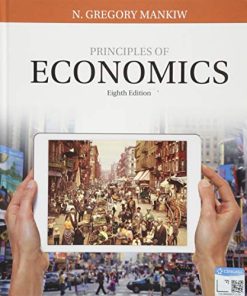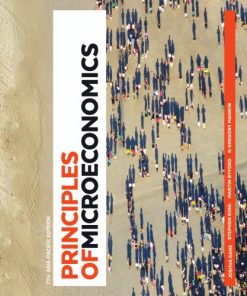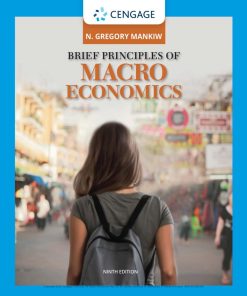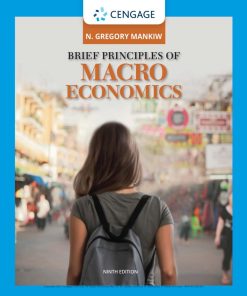Principles of Macroeconomics 7th Edition by Gregory Mankiw 8214351056 9798214351056
$50.00 Original price was: $50.00.$25.00Current price is: $25.00.
Principles of Macroeconomics 7th Edition by N. Gregory Mankiw – Ebook PDF Instant Download/DeliveryISBN: 8214351056, 9798214351056
Full download Principles of Macroeconomics 7th Edition after payment.

Product details:
ISBN-10 : 8214351056
ISBN-13 : 9798214351056
Author: N. Gregory Mankiw
Gain a strong foundation in macroeconomics with today’s most popular economics text, trusted by students worldwide — Mankiw’s PRINCIPLES OF MACROECONOMICS, 10E. Using a clear, inviting writing style, this edition focuses exclusively on content to help you better understand the world and economy in which you live. You become a more astute participant in today’s economic environment as you learn the potential and limits of economic policy. The latest examples and learning features bring macroeconomic principles to life as author Gregory Mankiw puts himself in the position of someone seeing economics for the first time. Dr. Mankiw’s goal is to emphasize the material you will find most relevant and interesting as you study macroeconomics. MindTap digital resources, Aplia digital homework solution and author videos are also available to help you further master key macroeconomic principles.
Principles of Macroeconomics 7th Table of contents:
Part I. Introduction
Chapter 1. Ten Principles of Economics
1-1. How People Make Decisions
1-1a. Principle 1: People Face Trade-Offs
1-1b. Principle 2: The Cost of Something Is What You Give Up to Get It
1-1c. Principle 3: Rational People Think at the Margin
1-1d. Principle 4: People Respond to Incentives
1-2. How People Interact
1-2a. Principle 5: Trade Can Make Everyone Better Off
1-2b. Principle 6: Markets Are Usually a Good Way to Organize Economic Activity
1-2c. Principle 7: Governments Can Sometimes Improve Market Outcomes
1-3. How the Economy as a Whole Works
1-3a. Principle 8: A Country’s Standard of Living Depends on Its Ability to Produce Goods and Services
1-3b. Principle 9: Prices Rise When the Government Prints Too Much Money
1-3c. Principle 10: Society Faces a Short-Run Trade-Off between Inflation and Unemployment
1-4. Conclusion
Chapter in a Nutshell
Key Concepts
Questions for Review
Problems and Applications
Chapter 2. Thinking Like an Economist
2-1. The Economist as Scientist
2-1a. The Scientific Method: Observation, Theory, and More Observation
2-1b. The Role of Assumptions
2-1c. Economic Models
2-1d. Our First Model: The Circular-Flow Diagram
2-1e. Our Second Model: The Production Possibilities Frontier
2-1f. Microeconomics and Macroeconomics
2-2. The Economist as Policy Adviser
In the News: Why Tech Companies Hire Economists
2-2a. Positive versus Normative Analysis
2-2b. Economists in Washington
2-2c. Why Economists’ Advice Is Often Not Followed
2-3. Why Economists Disagree
2-3a. Differences in Scientific Judgments
2-3b. Differences in Values
2-3c. Perception versus Reality
2-4. Let’s Get Going
Chapter in a Nutshell
Key Concepts
Questions for Review
Problems and Applications
Appendix. Graphing: A Brief Review
Chapter 3. Interdependence and the Gains from Trade
3-1. A Parable for the Modern Economy
3-1a. Production Possibilities
3-1b. Specialization and Trade
3-2. Comparative Advantage: The Driving Force of Specialization
3-2a. Absolute Advantage
3-2b. Opportunity Cost and Comparative Advantage
3-2c. Comparative Advantage and Trade
3-2d. The Price of the Trade
3-3. Applications of Comparative Advantage
3-3a. Should Naomi Osaka Mow Her Own Lawn?
3-3b. Should the United States Trade with Other Countries?
3-4. Conclusion
In The News: Economics within a Marriage
Chapter in a Nutshell
Key Concepts
Questions for Review
Problems and Applications
Part II. How Markets Work
Chapter 4. The Market Forces of Supply and Demand
4-1. Markets and Competition
4-1a. What Is a Market?
4-1b. What Is Competition?
4-2. Demand
4-2a. The Demand Curve: The Relationship between Price and Quantity Demanded
4-2b. Market Demand versus Individual Demand
4-2c. Shifts in the Demand Curve
4-3. Supply
4-3a. The Supply Curve: The Relationship between Price and Quantity Supplied
4-3b. Market Supply versus Individual Supply
4-3c. Shifts in the Supply Curve
4-4. Supply and Demand Together
4-4a. Equilibrium
4-4b. Three Steps to Analyzing Changes in Equilibrium
In The News: Price Increases after Disasters
4-5. Conclusion: How Prices Allocate Resources
Chapter in a Nutshell
Key Concepts
Questions for Review
Problems and Applications
Chapter 5. Elasticity and Its Application
5-1. The Elasticity of Demand
5-1a. The Price Elasticity of Demand and Its Determinants
5-1b. The Price Elasticity of Demand, with Numbers
5-1c. The Midpoint Method: A Better Way to Calculate Percentage Changes and Elasticities
5-1d. The Variety of Demand Curves
5-1e. Total Revenue and the Price Elasticity of Demand
5-1f. Elasticity and Total Revenue along a Linear Demand Curve
5-1g. Other Demand Elasticities
5-2. The Elasticity of Supply
5-2a. The Price Elasticity of Supply and Its Determinants
5-2b. The Price Elasticity of Supply, with Numbers
5-2c. The Variety of Supply Curves
5-3. Three Applications of Supply, Demand, and Elasticity
5-3a. Can Good News for Farming Be Bad News for Farmers?
5-3b. Why Has OPEC Failed to Keep the Price of Oil High?
5-3c. Does Drug Interdiction Increase or Decrease Drug-Related Crime?
In The News: Elasticity of Supply and Demand in the Ride-share Market
5-4. Conclusion
Chapter in a Nutshell
Key Concepts
Questions for Review
Problems and Applications
Chapter 6. Supply, Demand, and Government Policies
6-1. The Surprising Effects of Price Controls
6-1a. How Price Ceilings Affect Market Outcomes
6-1b. How Price Floors Affect Market Outcomes
6-1c. Evaluating Price Controls
6-2. The Surprising Study of Tax Incidence
6-2a. How Taxes on Sellers Affect Market Outcomes
6-2b. How Taxes on Buyers Affect Market Outcomes
6-2c. Elasticity and Tax Incidence
In The News: Should the Minimum Wage Be $15 an Hour?
6-3. Conclusion
Chapter in a Nutshell
Key Concepts
Questions for Review
Problems and Applications
Part III. Markets and Welfare
Chapter 7. Consumers, Producers, and the Efficiency of Markets
7-1. Consumer Surplus
7-1a. Willingness to Pay
7-1b. Using the Demand Curve to Measure Consumer Surplus
7-1c. How a Lower Price Raises Consumer Surplus
7-1d. What Does Consumer Surplus Measure?
7-2. Producer Surplus
7-2a. Cost and the Willingness to Sell
7-2b. Using the Supply Curve to Measure Producer Surplus
7-2c. How a Higher Price Raises Producer Surplus
7-3. Market Efficiency
7-3a. Benevolent Social Planners
7-3b. Evaluating the Market Equilibrium
7-4. Conclusion: Market Efficiency and Market Failure
In The News: How Ticket Resellers Help Allocate Scarce Resources
Chapter in a Nutshell
Key Concepts
Questions for Review
Problems and Applications
Chapter 8. Application: The Costs of Taxation
8-1. The Deadweight Loss of Taxation
8-1a. How a Tax Affects Market Participants
8-1b. Deadweight Losses and the Gains from Trade
8-2. The Determinants of the Deadweight Loss
The Deadweight Loss Debate Case Study:
8-3. Deadweight Loss and Tax Revenue as Taxes Vary
The Laffer Curve and Supply-Side Economics Case Study:
8-4. Conclusion
Chapter in a Nutshell
Key Concepts
Questions for Review
Problems and Applications
Chapter 9. Application: International Trade
9-1. The Determinants of Trade
9-1a. The Equilibrium without Trade
9-1b. The World Price and Comparative Advantage
9-2. The Winners and Losers from Trade
9-2a. The Gains and Losses of an Exporting Country
9-2b. The Gains and Losses of an Importing Country
9-2c. The Effects of a Tariff
9-2d. The Lessons for Trade Policy
9-2e. Other Benefits of International Trade
9-3. The Arguments for Restricting Trade
9-3a. The Jobs Argument
9-3b. The National-Security Argument
9-3c. The Infant-Industry Argument
9-3d. The Unfair-Competition Argument
9-3e. The Protection-as-a-Bargaining-Chip Argument
In The News: Trade as a Tool for Economic Development
9-4. Conclusion
Chapter in a Nutshell
Key Concepts
Questions for Review
Problems and Applications
Part IV. The Data of Macroeconomics
Chapter 10. Measuring a Nation’s Income
10-1. The Economy’s Income and Expenditure
10-2. The Measurement of GDP
10-2a. “GDP Is the Market Value …”
10-2b. “… of All …”
10-2c. “… Final …”
10-2d. “… Goods and Services …”
10-2e. “… Produced …”
10-2f. “… Within a Country …”
10-2g. “… In a Given Period.”
10-3. The Components of GDP
10-3a. Consumption
10-3b. Investment
10-3c. Government Purchases
10-3d. Net Exports
10-4. Real versus Nominal GDP
10-4a. A Numerical Example
10-4b. The GDP Deflator
10-5. Is GDP a Good Measure of Economic Well-Being?
International Differences in GDP and the Quality of Life Case Study:
In The News: Sex, Drugs, and GDP
10-6. Conclusion
Chapter in a Nutshell
Key Concepts
Questions for Review
Problems and Applications
Chapter 11. Measuring the Cost of Living
11-1. The Consumer Price Index
11-1a. How the CPI Is Calculated
11-1b. Problems in Measuring the Cost of Living
11-1c. The GDP Deflator versus the Consumer Price Index
11-2. Correcting Economic Variables for the Effects of Inflation
11-2a. Dollar Figures from Different Times
11-2b. Indexation
11-2c. Real and Nominal Interest Rates
11-3. Conclusion
Chapter in a Nutshell
Key Concepts
Questions for Review
Problems and Applications
Part V. The Real Economy in the Long Run
Chapter 12. Production and Growth
12-1. Economic Growth around the World
12-2. Productivity: Its Role and Determinants
12-2a. Why Productivity Is So Important
12-2b. How Productivity Is Determined
12-3. Economic Growth and Public Policy
12-3a. Saving and Investment
12-3b. Diminishing Returns and the Catch-Up Effect
12-3c. Investment from Abroad
12-3d. Education
12-3e. Health and Nutrition
12-3f. Property Rights and Political Stability
12-3g. Free Trade
12-3h. Research and Development
12-3i. Population Growth
In the News: The Secret Sauce of American Prosperity
12-4. Conclusion: The Importance of Long-Run Growth
Chapter in a Nutshell
Key Concepts
Questions for Review
Problems and Applications
Chapter 13. Saving, Investment, and the Financial System
13-1. Financial Institutions in the U.S. Economy
13-1a. Financial Markets
13-1b. Financial Intermediaries
13-1c. Summing Up
13-2. Saving and Investment in the National Income Accounts
13-2a. Some Important Identities
13-2b. The Meaning of Saving and Investment
13-3. The Market for Loanable Funds
13-3a. Supply and Demand for Loanable Funds
13-3b. Policy 1: Saving Incentives
13-3c. Policy 2: Investment Incentives
13-3d. Policy 3: Government Budget Deficits and Surpluses
13-4. Conclusion
Chapter in a Nutshell
Key Concepts
Questions for Review
Problems and Applications
Chapter 14. The Basic Tools of Finance
14-1. Present Value: Measuring the Time Value of Money
14-2. Managing Risk
14-2A. Risk Aversion
14-2b. The Markets for Insurance
14-2c. Diversification of Firm-Specific Risk
14-2d. The Trade-Off between Risk and Return
14-3. Asset Valuation
14-3a. Fundamental Analysis
14-3b. The Efficient Markets Hypothesis
14-3c. Market Irrationality
In The News: The Perils of Investing with a Y Chromosome
14-4. Conclusion
Chapter in a Nutshell
Key Concepts
Questions for Review
Problems and Applications
Chapter 15. Unemployment
15-1. Identifying Unemployment
15-1a. How Is Unemployment Measured?
15-1b. Does the Unemployment Rate Measure What We Want It to Measure?
15-1c. How Long Are the Unemployed without Work?
15-1d. Why Are There Always Some People Unemployed?
15-2. Job Search
15-2a. Why Some Frictional Unemployment Is Inevitable
15-2b. Public Policy and Job Search
15-2c. Unemployment Insurance
15-3. Minimum-Wage Laws
Who Earns the Federal Minimum Wage? Case Study:
15-4. Unions and Collective Bargaining
15-4a. The Economics of Unions
15-4b. Are Unions Good or Bad for the Economy?
15-5. The Theory of Efficiency Wages
15-5a. Worker Health
15-5b. Worker Turnover
15-5c. Worker Quality
15-5d. Worker Effort
15-5e. Worker Morale
In The News: Efficiency Wages in Practice
15-6. Conclusion
Chapter in a Nutshell
Key Concepts
Questions for Review
Problems and Applications
Part VI. Money and Prices in the Long Run
Chapter 16. The Monetary System
16-1. The Meaning of Money
16-1a. The Functions of Money
16-1b. The Kinds of Money
16-1c. Money in the U.S. Economy
16-2. The Federal Reserve System
16-2a. The Fed’s Organization
16-2b. The Federal Open Market Committee
16-3. Banks and the Money Supply
16-3a. The Simple Case of 100-Percent-Reserve Banking
16-3b. Money Creation with Fractional-Reserve Banking
16-3c. The Money Multiplier
16-3d. Bank Capital, Leverage, and the Financial Crisis of 2008–2009
16-4. The Fed’s Tools of Monetary Control
16-4a. How the Fed Influences the Quantity of Reserves
16-4b. How the Fed Influences the Reserve Ratio
16-4c. Problems in Controlling the Money Supply
16-4d. The Federal Funds Rate
In The News: A Trip to Jekyll Island
16-5. Conclusion
Chapter in a Nutshell
Key Concepts
Questions for Review
Problems and Applications
Chapter 17. Money Growth and Inflation
17-1. The Classical Theory of Inflation
17-1a. The Level of Prices and the Value of Money
17-1b. Money Supply, Money Demand, and Monetary Equilibrium
17-1c. The Effects of a Monetary Injection
17-1d. A Brief Look at the Adjustment Process
17-1e. The Classical Dichotomy and Monetary Neutrality
17-1f. Velocity and the Quantity Equation
17-1g. The Inflation Tax
17-1h. The Fisher Effect
17-2. The Costs of Inflation
17-2a. A Fall in Purchasing Power? The Inflation Fallacy
17-2b. Shoeleather Costs
17-2c. Menu Costs
17-2d. Relative-Price Variability and the Misallocation of Resources
17-2e. Inflation-Induced Tax Distortions
17-2f. Confusion and Inconvenience
17-2g. A Special Cost of Unexpected Inflation: Arbitrary Redistributions of Wealth
17-2h. Inflation Is Bad, but Deflation May Be Worse
In The News: Life during Hyperinflation
17-3. Conclusion
Chapter in a Nutshell
Key Concepts
Questions for Review
Problems and Applications
Part VII. The Macroeconomics of Open Economies
Chapter 18. Open-Economy Macroeconomics: Basic Concepts
18-1. The International Flows of Goods and Capital
18-1a. The Flow of Goods: Exports, Imports, and Net Exports
18-1b. The Flow of Financial Resources: Net Capital Outflow
18-1c. The Equality of Net Exports and Net Capital Outflow
18-1d. Saving, Investment, and Their Relationship to International Flows
18-1e. Summing Up
18-2. The Prices for International Transactions: Real and Nominal Exchange Rates
18-2a. Nominal Exchange Rates
18-2b. Real Exchange Rates
18-3. A First Theory of Exchange-Rate Determination: Purchasing-Power Parity
18-3a. The Basic Logic of Purchasing-Power Parity
18-3b. Implications of Purchasing-Power Parity
18-3c. Limitations of Purchasing-Power Parity
18-4. Conclusion
Chapter in a Nutshell
Key Concepts
Questions for Review
Problems and Applications
Chapter 19. A Macroeconomic Theory of the Open Economy
19-1. Supply and Demand for Loanable Funds and for Foreign-Currency Exchange
19-1a. The Market for Loanable Funds
19-1b. The Market for Foreign-Currency Exchange
19-2. Equilibrium in the Open Economy
19-2a. Net Capital Outflow: The Link between the Two Markets
19-2b. Simultaneous Equilibrium in Two Markets
19-3. How Policies and Events Affect an Open Economy
19-3a. Government Budget Deficits
19-3b. Trade Policy
19-3c. Political Instability and Capital Flight
In the News: Separating Fact from Fiction
19-4. Conclusion
Chapter in a Nutshell
Key Concepts
Questions for Review
Problems and Applications
Part VIII. Short-Run Economic Fluctuations
Chapter 20. Aggregate Demand and Aggregate Supply
20-1. Three Key Facts about Economic Fluctuations
20-1a. Fact 1: Economic Fluctuations Are Irregular and Unpredictable
20-1b. Fact 2: Most Macroeconomic Quantities Fluctuate Together
20-1c. Fact 3: As Output Falls, Unemployment Rises
20-2. Explaining Short-Run Economic Fluctuations
20-2a. The Assumptions of Classical Economics
20-2b. The Reality of Short-Run Fluctuations
20-2c. The Model of Aggregate Demand and Aggregate Supply
20-3. The Aggregate-Demand Curve
20-3a. Why the Aggregate-Demand Curve Slopes Downward
20-3b. Why the Aggregate-Demand Curve Might Shift
20-4. The Aggregate-Supply Curve
20-4a. Why the Aggregate-Supply Curve Is Vertical in the Long Run
20-4b. Why the Long-Run Aggregate-Supply Curve Might Shift
20-4c. Using Aggregate Demand and Aggregate Supply to Depict Long-Run Growth and Inflation
20-4d. Why the Aggregate-Supply Curve Slopes Upward in the Short Run
20-4e. Why the Short-Run Aggregate-Supply Curve Might Shift
20-5. Two Causes of Economic Fluctuations
20-5a. The Effects of a Shift in Aggregate Demand
20-5b. The Effects of a Shift in Aggregate Supply
In the News: The Strange Downturn of 2020
20-6. Conclusion
Chapter in a Nutshell
Key Concepts
Questions for Review
Problems and Applications
Chapter 21. The Influence of Monetary and Fiscal Policy on Aggregate Demand
21-1. How Monetary Policy Influences Aggregate Demand
21-1a. The Theory of Liquidity Preference
21-1b. The Downward Slope of the Aggregate-Demand Curve
21-1c. Changes in the Money Supply
21-1d. The Role of Interest-Rate Targets in Fed Policy
21-1e. The Zero Lower Bound
21-2. How Fiscal Policy Influences Aggregate Demand
21-2a. Changes in Government Purchases
21-2b. The Multiplier Effect
21-2c. A Formula for the Spending Multiplier
21-2d. Other Applications of the Multiplier Effect
21-2e. The Crowding-Out Effect
21-2f. Changes in Taxes
21-3. Using Policy to Stabilize the Economy
21-3a. The Case for Active Stabilization Policy
21-3b. The Case against Active Stabilization Policy
21-3c. Automatic Stabilizers
21-4. Conclusion
Chapter in a Nutshell
Key Concepts
Questions for Review
Problems and Applications
Chapter 22. The Short-Run Trade-Off between Inflation and Unemployment
22-1. The Phillips Curve
22-1a. Origins of the Phillips Curve
22-1b. Aggregate Demand, Aggregate Supply, and the Phillips Curve
22-2. Shifts in the Phillips Curve: The Role of Expectations
22-2a. The Long-Run Phillips Curve
22-2b. The Meaning of “Natural”
22-2c. Reconciling Theory and Evidence
22-2d. The Short-Run Phillips Curve
22-2e. The Natural Experiment for the Natural-Rate Hypothesis
22-3. Shifts in the Phillips Curve: The Role of Supply Shocks
22-4. The Cost of Reducing Inflation
22-4a. The Sacrifice Ratio
22-4b. Rational Expectations and the Possibility of Costless Disinflation
22-4c. The Volcker Disinflation
22-5. Recent History
22-5a. The Greenspan Era
22-5b. The Great Recession
22-5c. The Pandemic
22-6. Conclusion
Chapter in a Nutshell
Key Concepts
Questions for Review
Problems and Applications
Part IX. Final Thoughts
Chapter 23. Six Debates over Macroeconomic Policy
23-1. How Actively Should Policymakers Try to Stabilize the Economy?
23-1a. The Case for Robust Stabilization Policy
23-1b. The Case for Modest Stabilization Policy
23-2. Should the Government Fight Recessions with Spending Hikes or Tax Cuts?
23-2a. The Case for Fighting Recessions with Spending Hikes
23-2b. The Case for Fighting Recessions with Tax Cuts
23-3. Should Monetary Policy Be Made by Rule or Discretion?
23-3a. The Case for Rule-based Monetary Policy
23-3b. The Case for Discretionary Monetary Policy
23-4. Should the Central Bank Aim for an Inflation Rate Near Zero?
23-4a. The Case for Near-Zero Inflation
23-4b. The Case for Living with Moderate Inflation
In the News: The Goals of Monetary Policy
23-5. Should the Government Balance Its Budget?
23-5a. The Case for a Balanced Budget
23-5b. The Case against a Balanced Budget
23-6. Should the Tax Laws Be Reformed to Encourage Saving?
23-6a. The Case for Promoting Saving through Tax Reform
23-6b. The Case against Promoting Saving through Tax Reform
23-7. Conclusion: Economic Policy and Shades of Gray
Chapter in a Nutshell
Questions for Review
Problems and Applications
Chapter 24. Appendix: How Economists Use Data
24-1. The Data That Economists Gather and Study
24-1a. Experimental Data
24-1b. Observational Data
24-1c. Three Types of Data
24-2. What Economists Do with Data
24-2a. Describing the Economy
24-2b. Quantifying Relationships
24-2c. Testing Hypotheses
24-2d. Predicting the Future
24-3. The Methods of Data Analysis
24-3a. Finding the Best Estimate
24-3b. Gauging Uncertainty
24-3c. Accounting for Confounding Variables
24-3d. Establishing Causal Effects
24-4. Conclusion
Chapter in a Nutshell
Key Concepts
Questions for Review
Problems and Applications
The Keynesian Cross
1. The Big Idea
2. The Basic Model
2a. The Determinants of Planned Expenditure
2b. The Equilibrium
2c. The Adjustment to Equilibrium
3. Applying the Model
3a. How to Shrink a Recessionary Gap
3b. The Paradox of Thrift
4. Conclusion: Back to the Aggregate-Demand Curve
People also search for Principles of Macroeconomics 7th:
is principles of macroeconomics hard
brief principles of macroeconomics
10 principles of macroeconomics
modern principles of macroeconomics
principles of macroeconomics pdf
Tags: Principles, Macroeconomics, Gregory Mankiw, economics text, students worldwide
You may also like…
Business & Economics - Economics
Business & Economics
Principles of Microeconomics, Asia-Pacific Edition N. Gregory Mankiw
Business & Economics
Brief principles of macroeconomics Ninth Edition N. Gregory Mankiw
Business & Economics - Professional Finance
Uncategorized
Business & Economics - Professional Finance
(EBook PDF) Principles of Microeconomics 8th Edition by Gregory Mankiw 9780176872823 full chapters
Business & Economics - Management & Leadership
Principles of Microeconomics by N. Gregory Mankiw 8TH Edition Gregory Mankiw
Uncategorized
Business & Economics - Industries











![Macroeconomics 11th Edition N. Gregory Mankiw [11 Ed.]](https://ebookmass.com/wp-content/uploads/2024/04/macroeconomics-48748296-247x296.jpg)